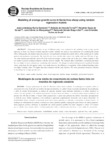Use este identificador para citar ou linkar para este item:
http://www.alice.cnptia.embrapa.br/alice/handle/doc/899506| Título: | Modeling of average growth curve in Santa Ines sheep using random regression models. |
| Autoria: | SAMENTO, J. L. R.  TORRES, R. de A.   SOUSA, W. H. de   ALBUQUERQUE, L. G. de   LOBO, R. N. B.   SOUSA, J. E. R. de   |
| Afiliação: | José Lindenberg Rocha Sarmento, Universidade Federal do Piauí (UFPI), Bom Jesus, PI, Brasil.; Robledo de Almeida Torres, UFV, Viçosa, MG, Brasil.; Wandrick Hauss de Sousa, EMEPA, João Pessoa, PB, Brasil.; Lucia Galvão de Albuquerque, UNESP, Jaboticabal, SP, Brasil.; RAIMUNDO NONATO BRAGA LOBO, CNPC; José Ernandes Rufino de Sousa, Universidade Federal do Piauí (UFPI), Bom Jesus, PI, Brasil. |
| Ano de publicação: | 2011 |
| Referência: | Revista Brasileira de Zootecnia, v. 40, n. 2, p. 314-322, 2011. |
| Conteúdo: | Abstract: Polynomial functions of age of different orders were evaluated in the modeling of the average growth trajectory in Santa Ines sheep in random regression models. Initially, the analyses were performed not considering the animal effect. Subsequently, the random regression analyses were performed including the random effects of the animal and its mother (genetic and permanent environment). The linear fit was lower, and the other orders were similar until near 100 days of age. The cubic function provided the closest fit of the observed averages, mainly at the end of the curve. Orders superior to this one tended to present incoherent behavior with the observed weights. The estimated direct heritabilities, considering the linear fit, were higher to those estimated by considering other functions. The changes in animal ranking based on predicted breeding values using linear fit and superior orders were small; however, the difference in magnitude of the predicted breeding values was higher, reaching values 77% higher than those obtained with the cubic function. The cubic polynomial function is efficient in describing the average growth curve. [Modelagem da curva média de crescimento de ovinos Santa Inês em modelos de regressão aleatória]. Resumo: Funções polinomiais da idade de diferentes ordens foram avaliadas na modelagem da trajetória média de crescimento de ovinos Santa Inês em modelos de regressão aleatória. As análises foram executadas inicialmente desconsiderando o efeito de animal. Posteriormente, as análises de regressão aleatória foram realizadas incluindo-se os efeitos aleatórios de animal e da mãe (genético e de ambiente permanente). O ajuste linear foi inferior, e as demais ordens foram semelhantes até próximo dos 100 dias de idade. A função cúbica proporcionou o ajuste mais próximo das médias observadas, principalmente ao final da curva. Ordens superiores a esta tenderam a apresentar comportamento incoerente com os pesos observados. As herdabilidades diretas estimadas considerando ajuste linear foram superiores às estimadas considerando as demais funções. As mudanças no ordenamento dos animais, com base nos valores genéticos preditos empregando ajuste linear e de ordens superiores, foram pequenas, porém, a diferença na magnitude dos valores genéticos preditos foi maior, chegando a valores 77% maiores que os obtidos com a função cúbica. A função polinomial cúbica é eficiente para descrever a curva média de crescimento. |
| Thesagro: | Ovino Melhoramento genético animal Genética animal Modelo matemático Curva de crescimento |
| NAL Thesaurus: | Sheep Animal breeding Animal genetics Breeding value Heritability Growth models Brazil |
| Palavras-chave: | Herdabilidade Funções polinomiais Regressão fixa Valor genético Modelo de regressão Modelo animal Raça Santa Inês |
| Tipo do material: | Artigo de periódico |
| Acesso: | openAccess |
| Aparece nas coleções: | Artigo em periódico indexado (CNPC)  |
Arquivos associados a este item:
| Arquivo | Descrição | Tamanho | Formato | |
|---|---|---|---|---|
| APIModeling.pdf | 546.87 kB | Adobe PDF |  Visualizar/Abrir |









